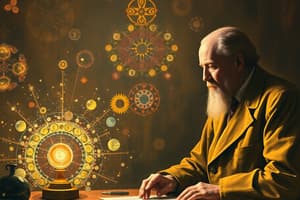Podcast
Questions and Answers
What conclusion did Rutherford draw from his experiment with positively charged particles?
What conclusion did Rutherford draw from his experiment with positively charged particles?
- Atoms are composed entirely of solid matter.
- Atoms mostly contain empty space with a central nucleus. (correct)
- Electrons exist in fixed orbits around the nucleus.
- The nucleus is negatively charged.
In Rutherford's model, how are electrons represented in relation to the nucleus?
In Rutherford's model, how are electrons represented in relation to the nucleus?
- Electrons do not exist outside the nucleus.
- Electrons are fixed in position relative to the nucleus.
- Electrons are located in a dense cloud within the nucleus.
- Electrons orbit the nucleus in a cloud-like structure. (correct)
What was the significance of Rutherford's experiments on previous atomic models?
What was the significance of Rutherford's experiments on previous atomic models?
- It rejected the existence of subatomic particles.
- It challenged the concept of atoms as indivisible particles. (correct)
- It affirmed that nucleons were responsible for atomic density.
- It reinforced the idea that atoms were primarily positive.
What characteristic of the nucleus is emphasized in Rutherford's atomic model?
What characteristic of the nucleus is emphasized in Rutherford's atomic model?
Which aspect of Rutherford's method was crucial in deriving his conclusions about atomic structure?
Which aspect of Rutherford's method was crucial in deriving his conclusions about atomic structure?
What was the main challenge posed by Rutherford's discovery regarding the structure of the atom?
What was the main challenge posed by Rutherford's discovery regarding the structure of the atom?
What concept did Niels Bohr introduce to improve upon Rutherford's atomic model?
What concept did Niels Bohr introduce to improve upon Rutherford's atomic model?
What significant particle was identified by James Chadwick in 1932?
What significant particle was identified by James Chadwick in 1932?
How did Rutherford's experiments with gold foil contribute to atomic theory?
How did Rutherford's experiments with gold foil contribute to atomic theory?
What does the term 'half-life' refer to in the context of radioactive materials?
What does the term 'half-life' refer to in the context of radioactive materials?
Which of the following was NOT proposed by Ernest Rutherford?
Which of the following was NOT proposed by Ernest Rutherford?
Which synthetic element is named in honor of Ernest Rutherford?
Which synthetic element is named in honor of Ernest Rutherford?
What fundamental building block did Rutherford identify through his research with alpha particles?
What fundamental building block did Rutherford identify through his research with alpha particles?
What discovery did Rutherford make in 1919 regarding atomic structure?
What discovery did Rutherford make in 1919 regarding atomic structure?
Which of the following awards did Rutherford receive for his contributions to chemistry?
Which of the following awards did Rutherford receive for his contributions to chemistry?
Which radiation types did Rutherford publish in 1899?
Which radiation types did Rutherford publish in 1899?
What was a significant change in atomic theory brought about by Rutherford's discoveries?
What was a significant change in atomic theory brought about by Rutherford's discoveries?
What was the primary focus of Rutherford's research after moving to McGill University?
What was the primary focus of Rutherford's research after moving to McGill University?
Which of the following best describes the Rutherford model of the atom proposed in 1911?
Which of the following best describes the Rutherford model of the atom proposed in 1911?
Who influenced Rutherford's early career by recommending him for a professorship?
Who influenced Rutherford's early career by recommending him for a professorship?
What did Rutherford's experiments ultimately demonstrate about atomic theory at the time?
What did Rutherford's experiments ultimately demonstrate about atomic theory at the time?
Flashcards are hidden until you start studying
Study Notes
Ernest Rutherford and the Atom
- Ernest Rutherford revolutionized our understanding of atoms by discovering their constituent parts and revealing their inner structure.
- He identified alpha and beta radiation, demonstrating the disintegration of elements.
- He proposed the "Rutherford model" of the atom, suggesting electrons orbit a tiny, positively charged nucleus.
- He discovered the proton and successfully transformed one element into another through nuclear fission.
Rutherford's Life and Work
- Rutherford was born in Brightwater, New Zealand, and later earned science degrees at Canterbury College.
- He received an overseas scholarship, leading him to Cambridge University where he worked with J.J. Thomson.
- He was appointed a professor at McGill University in Montreal, Canada, where his research on the disintegration of elements earned him the Nobel Prize in Chemistry.
- Rutherford's work built upon Henri Becquerel and J.J. Thomson's discoveries about radioactivity and the electron.
Rutherford's Atomic Model
- Rutherford's model challenged the prevailing "plum pudding" model, which envisioned a diffuse cloud of positive charge with embedded electrons.
- He conducted experiments by bombarding a thin gold foil with alpha particles, observing that some were deflected or bounced back, revealing a concentrated positive charge within the atom.
- He concluded that most of the atom's mass and positive charge were concentrated in a small, dense nucleus at the atom's center.
- He proposed that electrons orbit the nucleus at fixed energy levels, similar to a miniature solar system.
The Discovery of the Atomic Nucleus and the Proton
- Rutherford's research led to the discovery of the proton, concluding that the nuclei of all elements are composed of these fundamental building blocks.
- He proposed that hydrogen's nucleus, with a positive charge, be called a proton.
The Neutron
- James Chadwick later discovered the neutron, a neutral particle residing within the nucleus alongside protons.
Legacy
- A synthetic element, Rutherfordium, was named in recognition of Rutherford's contributions to atomic theory.
Studying That Suits You
Use AI to generate personalized quizzes and flashcards to suit your learning preferences.



